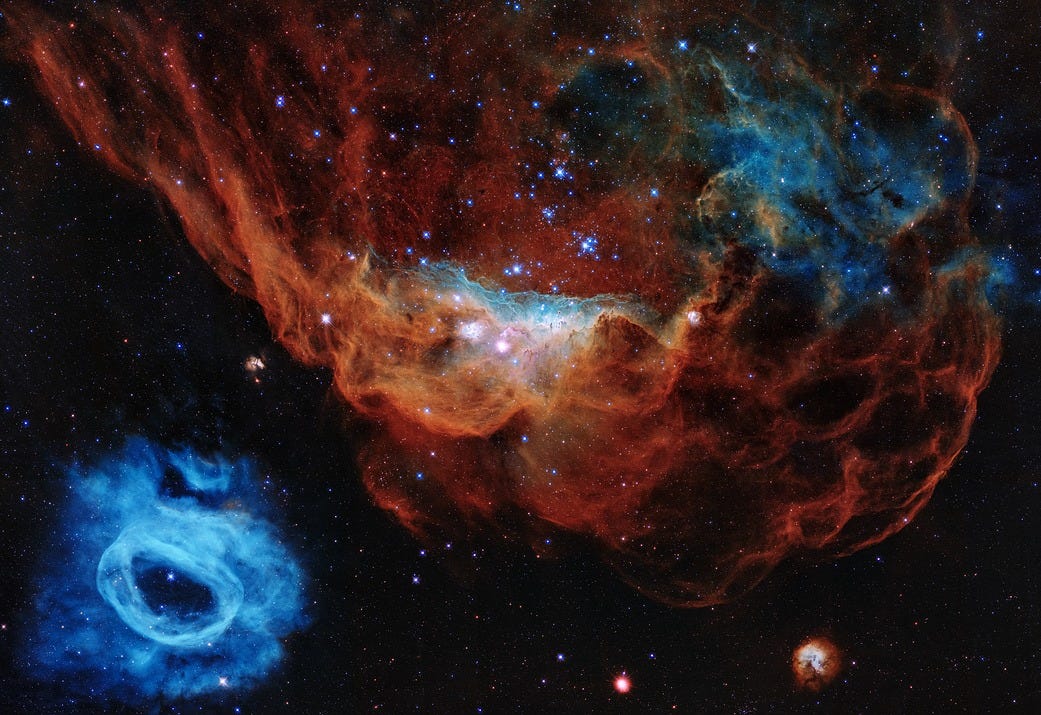What an offer! Save Hubble for little or no cost?
NASA and SpaceX study private mission to boost telescope

Full Throttle posts twice a week. It's free. Please share and subscribe here.
The Hubble Space Telescope has dazzled us with images of the universe. It’s new cousin, the James Webb Space Telescope, is looking even deeper into the cosmos. Hubble has cheated death already through repair missions by NASA astronauts. Now it is an unusual source that is offering to boost its orbit, extending its life for a decade or more. And here is the kicker, they might do it for free, or little cost to us taxpayers!

Image from the Hubble Space Telescope. The giant red nebula (NGC 2014) and its smaller blue neighbor (NGC 2020) are part of a vast star-forming region in the Large Magellanic Cloud, a satellite galaxy of the Milky Way, located 163,000 light-years away. (Credit: NASA)
It is SpaceX, a NASA contractor for travel of crews and cargo to the International Space Station and a moon lander, that approached the space agency with the question- how about we re-boost the Hubble telescope for you?
HUBBLE LOSING ALTITUDE
Hubble’s orbit, like all unpowered orbiting satellites, is deteriorating. Hubble was designed to orbit about 375 miles above earth. The last time the space shuttle and its astronauts visited in 2009, Hubble was 350 miles above Earth. Today, the telescope is 335 miles above Earth. If nothing is done, Hubble has a 50% chance to reenter Earth’s atmosphere in 2037.
NASA is interested in SpaceX’s proposal. Just days ago, NASA and SpaceX announced they will spend the next six months studying whether a possible re-boost makes sense, and if a mission to Hubble could also service the old telescope, which has been working for more than three decades. That means delicately changing out parts.

Jared Isaacman onhis first trip to space as part of his Inspiration 4 mission. (Credit: Inspiration 4)
This brings us to Jared Isaacman. Do you remember him? The billionaire led the first fully private mission to space, called Inspiration 4. He has created a space company called Polaris and is planning a second flight to space including an EVA (extravehicular activity). He now wonders whether he could be the one to boost Hubble.
PRIVATE RE-BOOST
“it’s absolutely exciting to think about the possibility of extending the life and capabilities of one of our greatest explorers. So Polaris is excited to assist in this study, and hopefully it does lead us down a path that ensures Hubble's ability to continue to serve science for decades into the future,” Isaacman told reporters.
Isaacman on the possibility of a private mission to boost the Hubble Space Telescope.
NASA, SpaceX, and Polaris all emphasized this is just a study to see, “if it is even technically feasible,” to use the SpaceX Dragon Capsule for such a mission. Isaacman tried to demur, but it sounded like he hopes this works out and he would like to fly this mission as part of Polaris Dawn, the companies first mission.
WHO PAYS?
“With little or no potential cost to the government, which you think would be of great benefit to just all all humanity, if you can extend the life and capabilities of an asset like Hubble,” would be fulfilling, Isaacman said.
Isaacman suggests the costs of such a re-boosting mission may be paid for by SpaceX and his company Polaris.
SpaceX, which is talking about refueling in orbit for its Starship and might be interested in servicing other orbiting spacecraft, sees great benefits in this potential mission.
SpaceX’s Jessica Jensen said, “it's really an honor for us if we wouldn't be able to extend this lifetime. But SpaceX really sees the future in that we are a spacefaring civilization. And that means that there are spaceships flying all over the place.” She mentioned the company wants to learn more about refueling in orbit and docking with various vehicles.
SpaceX believes it will learn a lot if a re-boost mission is undertaken.
There are roadblocks. SpaceX may have to modify the Dragon Capsule to make it work on such a mission.
HUBBLE FIXER
How realistic is this? I talked with an astronaut who worked on the last two missions to repair Hubble. Mike Massimino had a lot to say about this study/discussion. That’s part two. But a bit of a tease- “Anything we can do to keep the telescope performing, as well as possible keep it as keep it up there, keep it alive, is worth it. I kind of dedicated my astronaut career the way it turned out to do just that. So I definitely think it's worth it. Yeah, absolutely. I hope they hope they go further.”
Further would include servicing the telescope. That’s a whole other can of worms. More about how that could be done on Wednesday.
Please share and subscribe here.
(Cover image credit: NASA)




